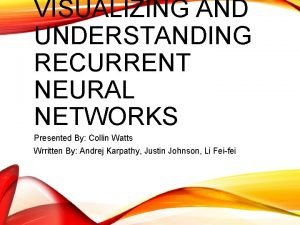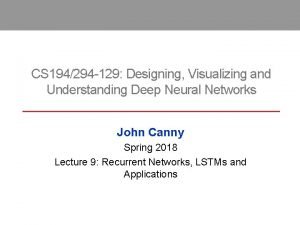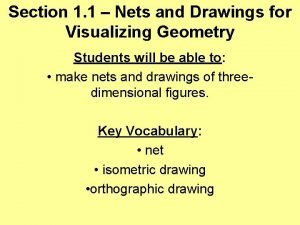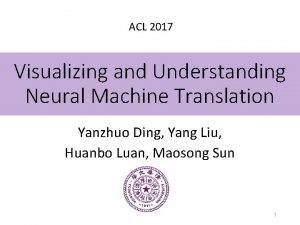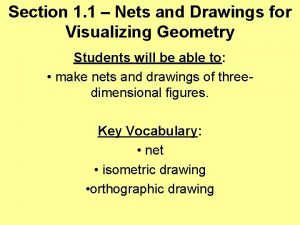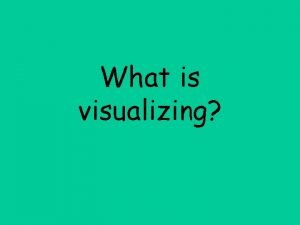Visualizing and Presenting in Research and Teaching Visualization














- Slides: 14

Visualizing and Presenting in Research and Teaching Visualization: Tools and Tips Negative Examples Jan-Philipp Söhn May 21 st, 2008

This is a good slide (38 pt) o This is an item o A second item o A third item (30 pt)

This is another good slide (34 pt) o This is a smaller item o A second item o Another item o A last item (24 pt, line spacing 1. 5)

What about this one? (38 pt) o These are items o And items o And items… (24 pt, line spacing 1. 5)

Here comes a bad slide o o These are even And even more n n n o o o smaller items (18 pt – really the limit) items And even more items (16 pt) And even more items And And And even more items even more items too many items

…and another one Artificial language - known colloquially or informally as a conlang - is a language whose phonology, grammar, and/or vocabulary have been devised by an individual or group, instead of having evolved naturally. There are many possible reasons to create a constructed language: to ease human communication (see international auxiliary language and code); to bring fiction or an associated constructed world to life; linguistic experimentation; celebration of one's aesthetic tastes in language; and language games. The synonym planned language is sometimes used to refer to international auxiliary languages, and by individuals who may disagree with the more common term "artificial". For example, few speakers of Interlingua consider their language artificial, since it has no invented content. While this is not true of Esperanto and Ido, some speakers of these languages also avoid the term "artificial language" because they deny that there is anything "unnatural" about the use of their language in human communication. Calling languages "planned" also addresses a difficulty with the term "constructed language": a few languages are loosely grouped under this heading as a result of shared history and uses but are not themselves viewed as constructed. Interlingua has a naturally occurring vocabulary and grammar that have been cataloged and standardized by an International Auxiliary Language Association, a linguistic research body. (14 pt)

Artificial Languages Artificial language - known colloquially or informally as a conlang - is a language whose phonology, grammar, and/or vocabulary have been devised by an individual or group, instead of having evolved naturally. There are many possible reasons to create a constructed language: to ease human communication (see international auxiliary language and code); to bring fiction or an associated constructed world to life; linguistic experimentation; celebration of one's aesthetic tastes in language; and language games. (24 pt)

Artificial Languages Artificial language - known colloquially or informally as a conlang - is a language whose phonology, grammar, and/or vocabulary have been devised by an individual or group, instead of having evolved naturally. There are many possible reasons to create a constructed language: to ease human communication (see international auxiliary language and code); to bring fiction or an associated constructed world to life; linguistic experimentation; celebration of one's aesthetic tastes in language; and language games. (25 pt)

Artificial Languages Artificial language - known colloquially or informally as a conlang - is a language whose phonology, grammar, and/or vocabulary have been devised by an individual or group, instead of having evolved naturally. There are many possible reasons to create a constructed language: to ease human communication (see international auxiliary language and code); to bring fiction or an associated constructed world to life; linguistic experimentation; celebration of one's aesthetic tastes in language; and language games. (25 pt)

Artificial Languages Artificial language - known colloquially or informally as a conlang - is a language whose phonology, grammar, and/or vocabulary have been devised by an individual or group, instead of having evolved naturally. There are many possible reasons to create a constructed language: to ease human communication (see international auxiliary language and code); to bring fiction or an associated constructed world to life; linguistic experimentation; celebration of one's aesthetic tastes in language; and language games. (25 pt)

Artificial Languages Artificial language - known colloquially or informally as a conlang - is a language whose phonology, grammar, and/or vocabulary have been devised by an individual or group, instead of having evolved naturally. There are many possible reasons to create a constructed language: to ease human communication (see international auxiliary language and code); to bring fiction or an associated constructed world to life; linguistic experimentation; celebration of one's aesthetic tastes in language; and language games. (25 pt)

Artificial Languages Artificial language - known colloquially or informally as a conlang - is a language whose phonology, grammar, and/or vocabulary have been devisedby an individual or group, instead of having evolved naturally. There are many possible reasons to create a constructed language: to ease human communication (see international auxiliary language and code); to bring fiction or an associated constructed world to life ; linguistic experimentation; celebration of one's aesthetic tastes in language; and language games.

artificial languages Artificial language - known colloquially or informally as a conlang - is a language whose phonology, grammar, and/or vocabulary have been devised by an individual or group, instead of having evolved naturally. There are many possible reasons to create a constructed language: to ease human communication (see international auxiliary language and code); to bring fiction or an associated constructed world to life; linguistic experimentation; celebration of one's aesthetic tastes in language; and language games.

The right font? Steel construction silk blouse Manager Dept. of Machine Engineering
 Ocar structure
Ocar structure Presenting a research proposal
Presenting a research proposal Presenting research findings
Presenting research findings Phases of microteaching
Phases of microteaching What is visualizing
What is visualizing Visualizing and understanding recurrent networks
Visualizing and understanding recurrent networks Visualizing and understanding convolutional networks
Visualizing and understanding convolutional networks Coco
Coco Visualizing and exploring data in business analytics
Visualizing and exploring data in business analytics Nets and drawings for visualizing geometry
Nets and drawings for visualizing geometry Visualizing and verbalizing activities
Visualizing and verbalizing activities Visualizing and understanding neural machine translation
Visualizing and understanding neural machine translation Analyzing and visualizing data with microsoft power bi
Analyzing and visualizing data with microsoft power bi 1-1 nets and drawings for visualizing geometry
1-1 nets and drawings for visualizing geometry Nets and drawings for visualizing geometry
Nets and drawings for visualizing geometry





